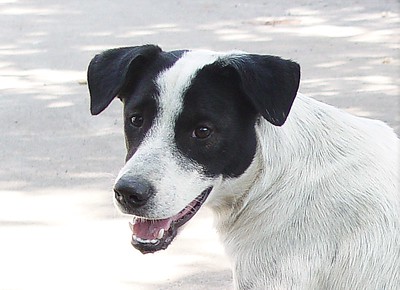Open Pedagogy
6.3 Yes, and Open Pedagogy
Karna Younger

The exciting part of open pedagogy is that it allows students to learn from and build upon each other’s work. We like to think of it as a type of improvisational comedy or improv. Admittedly we know almost nothing about improv, but we appreciate improv’s cardinal rule: “yes, and …” (and its lesser-known counterpart “no, but …”). With “yes, and …” improvisors must accept what their fellow players toss at them but can build upon it to create something new. So, if I tell you the black and white dog pictured here is a panda, then we would collaborate on telling a funny story about a panda with floppy ears. In our lay opinion, the “yes, and …” helps create a brave space where funny people can collaboratively learn and create together.
In open pedagogy, the “yes, and …” is a bit more complicated. But the parameters of open pedagogy are intended to foster a similar improvisational community where students and instructors can feel comfortable turning imperfect ideas into authentic learning experiences that add value to the world.
All the Feels about Open Pedagogy
A number of students indicate that open pedagogy empowers students to “yes, and” their course materials. If their OER is lacking, including in terms of social justice and DEIA, students will take the opportunity to make a difference.
Students have reported finding a greater sense of agency and pride in developing their critical thinking skills through open pedagogy projects, Virginia Clinton-Lisell (2021) found in her systematic review of open pedagogy research.[1] Fortified by such intrinsic motivators, “students perceived more opportunities to express their identities and share their voice with renewable assignments,” according to Clinton-Lisell and Lindsey Gwozdz’s 2023 survey of students.[2] When students believed their course materials were not inclusive and diverse, or lacking in recognitive justice, then they felt empowered to publicly share their work to improve the course materials. Students published their work to increase representational justice as defined by Lambert’s (2018) social justice-centered definition of OER, the authors found.
But open pedagogy is an art and reflexive practice that can take time and effort to meet student needs. For instance, open pedagogy may induce some anxiety in students (Maultsaid and Harrison, 2023; Clinton-Lisell and Gwozdz, 2023). Stress over “public sharing, shyness, and disagreements with group members” may prevent some from sharing their work publicly.[3] Even though many students who share their work report higher levels of competence in their work,[4] the road to achieving this confidence may be easier for some than others. Students who “freak out” and are “stressed” over publishing accurate and quality work also need greater transparency about the rationale and benefits of open pedagogy as well as encouragement through the creation process.[5]
Collaboration
As with improv, there isn’t really a set way to practice open pedagogy. But there are some general guidelines we can recommend to collaborate with your students, ease their anxieties, and empower their voices. The remainder of this chapter will walk you through this caring process.
Resources
Clinton-Lisell, V. (2021). Open Pedagogy: A Systematic Review of Empirical Findings. Journal of Learning for Development, 8(2), 255–268. https://doi.org/10.56059/jl4d.v8i2.511.
Clinton-Lisell, V., & Gwozdz, L. (2023). Understanding Student Experiences of Renewable and Traditional Assignments. College Teaching, 71(2), 125–134. https://doi.org/10.1080/87567555.2023.2179591. CC BY-NC 4.0.
Lambert, S.R. (2018). “Changing our (Dis)Course: A Distinctive Social Justice Aligned Definition of Open Education,” Journal of Learning for Development, 5(3). CC BY-SA.
Maultsaid, D., & Harrison, M. (2023). Can Open Pedagogy Encourage Care? Student Perspectives . The International Review of Research in Open and Distributed Learning, 24(3), 77–98. https://doi.org/10.19173/irrodl.v24i3.6901
